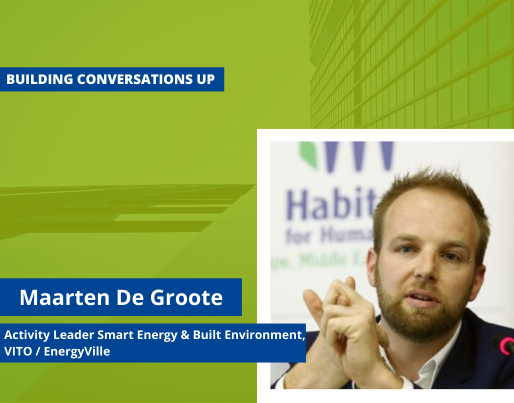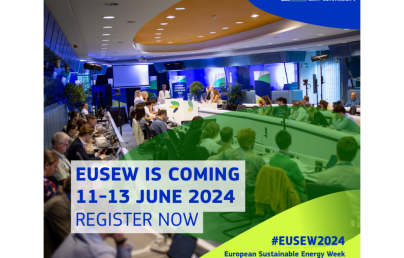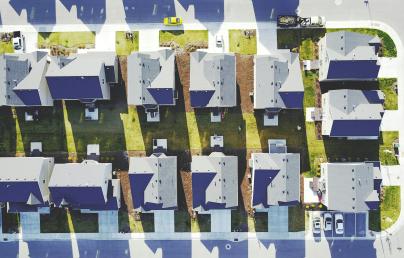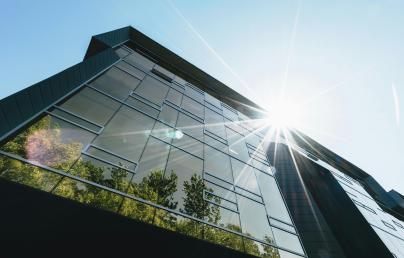Maarten De Groote: “Scaling up PENs will require a more substantial contribution from private finance”

Maarten De Groote: “Scaling up PENs will require a more substantial contribution from private finance”
Maarten De Groote has 20 years’ experience in the energy transition of the built environment.
As activity leader at VITO/EnergyVille, he coordinates the European project oPEN Lab, leading the transition to Positive Energy Neighbourhoods. With his policy and innovation experience in the construction sector and energy efficient, sustainable, and smart buildings, he successfully elevated these topics into European spotlights. Maarten holds a Master’s Degree in Industrial Design and is an Energy & Climate Postgraduate, both consolidate his unique approach.
BUILD UP (BUP): What is the concept of a Positive Energy Neighbourhood (PEN), and how does it differ from traditional neighbourhoods in terms of energy usage and sustainability?
MAARTEN DE GROOTE (MDG): In order to optimally decarbonise the urban environment, it is crucial not to approach each building separately, but rather to implement fully interoperable solutions at the neighbourhood level. This is so that energy efficiency is improved as well as integrating local renewables and excess heat sources more effectively.
Positive Energy Neighbourhoods (PEN) are highly energy-efficient and flexible urban neighbourhoods, in which buildings, energy systems, and mobility infrastructure work in harmony to achieve a surplus production of renewable energy. Instead of retrofitting buildings to an energy positive level from an individual perspective, PENs will approach both an integrated and aggregated energy solution approach. An integrated energy solution approach addresses both individual building measures and urban functionalities, and this happens on four levels:
1. Between building and neighbourhood infrastructures, for example, electric vehicle charging, district heating, common solar PV installation,
2. Within the same building, such as integration of technologies and techniques, for example active control and flexibility,
3. Between buildings, for example shared heat pumps, and
4. Between the building sector and other sectors, mainly energy (e.g., demand flexibility), industry (e.g., use of excess industrial heat for district heating) and mobility (e.g., V2G).
Figure 1 - Complementary information provided by the expert: An integrated approach towards positive energy neighbourhoods (M. De Groote)
The aggregation of renovation projects can lead to a reduction in overall costs and time overruns and can benefit from the pooling of financing and facilitation services. Cluster analyses at the neighbourhood scale will lead to designs, development, and testing of the optimal renovation and technology pathways towards PEN-level.
Life-cycle thinking should be consolidated into construction or refurbishments through the adoption of planning, design, and construction methods focused on the reduction of embodied emissions, pollution, operational costs, and time.
“The aggregation of renovation projects can lead to a reduction in overall costs and time overruns, as well as pooling of financing and facilitation services”
Residents should be involved in the design and implementation of PEN plans early on to make sure user interfaces are easily accessible and that the smart appliances fit their needs, which is why thorough stakeholder engagement activities are part of most PEN projects.
A common misconception is that PENs are a means to an end… After all, an urban energy transition is in constant evolution, a never-ending story. This is due to continual environment changes: evolving social context, new urban development, adapted legislation, novel technologies, increased electric vehicles and thus storage capacity, more dynamic energy markets, carbon intensity of electricity, energy prices, etc. As such, there is a strong analogy with the theory of evolution. If an environment changes, the traits that enhance ‘survival’ in that environment will also gradually change or evolve. Although the DNA between PENs varies, the implementation and evolution of different PENs is not a process of chance. The environment determines the probability of success in the urban energy transition.
BUP: What are the economic benefits of positive energy neighbourhoods, both for residents and the broader community? How can they contribute to energy efficiency targets?
MDG: Renovations at the district and neighbourhood level can lead to significant potential cost savings through economies of scale and smart logistics. They can also be more attractive to investors thanks to project aggregation and distributed risk portfolios. Aggregating the demand for renovation from several individual building owners in a neighbourhood can increase market prospects for those involved in selling or supplying new products and services. Investments in shared assets specific to PENs, while costly, can generate significant additional cash flows by selling aggregated excess energy and flexibility services to the market. However, regulatory and market barriers currently limit the ability of PENs and energy communities to sell flexibility services to the market.
While servitisation can be one promising avenue towards mobilising private investment in PENs, selling excess energy and flexibility services to the market provides only a limited input to a cost-benefit analysis, which does not capture the multiple benefits of PENs. The transition to energy-positive buildings and neighbourhoods will not be driven by energy savings alone but rather by emotionally charged benefits like indoor environmental quality, safety, health, and quality of life. Measures simultaneously addressing energy performance and a healthy indoor environment are thus key to increase the demand for PENs. These benefits do not stop with residents but can be felt in the surrounding neighbourhood.
Examples include growth of local businesses and local job creation as a result of urban regeneration and the improvement of community facilities, accessibility, safety, and public spaces. Synergies with the social agenda become evident when scaled up to neighbourhood level. PEN initiatives underscore the importance of co-design, social support, and community engagement to achieve maximum impact and ensure a socially inclusive transformation.
“Regulatory and market barriers currently limit the ability of PENs and energy communities to sell flexibility services to the market”
Current economic trends pose a threat to the success of renovations in the EU and pioneer projects such as PENs, making it harder to reach the targets of the Renovation Wave. According to Eurostat data, construction costs increased by 30% between 2016 and 2022. In particular, high inflation and higher borrowing costs risk jeopardising renovation projects. Increases in the overall cost of living have impacted homeowners’ ability to finance additional household works. Pilot PEN projects rely heavily on public funding. Scaling up PENs will require a more substantial contribution from private finance. The public sector should encourage and engage in dialogue with the construction and financial communities to improve collaboration and recognise the multiple benefits of PENs for homeowners, communities, and society. Identifying and assessing the multiple positive impacts of neighbourhood approaches will increase their attractiveness to responsible investors and developers seeking to realise their fiduciary duty to understand and actively manage environmental, social, and governance (ESG) and climate-related risks. Policymakers and market actors should commit to tracking social and environmental impacts, exchanging best practices to build capacity, and promoting PENs as investments that maximise benefits in all ESG dimensions
BUP: Are there specific EU policies or regulations that support the establishment and growth of positive energy neighbourhoods? And how can national governments encourage their development?
MDG: Ongoing EU policy initiatives (i.e., REPowerEU, NextGenerationEU, the EU Green Deal and the Renovation Wave) have so far failed to apply an integrated solution to the excessive use of fossil fuels, which is a problem beyond a single building or gas pipe. The European Commission’s Renovation Wave strategy highlights the importance of neighbourhood approaches, with a dedicated section on “placing an integrated, participatory and neighbourhood-based approach at the heart of the Renovation Wave”. The strategy rightfully concludes that “synergies for renovation become evident when scaled up to district and community approaches. Aggregating projects at this level may lead to zero-energy or even positive energy districts”.
Even though comprehensive renovation strategies and neighbourhood approaches are being positively referenced in the Renovation Wave strategy, the concept of neighbourhoods as micro-energy hubs is still largely overlooked by policymakers. No long-term regulatory targets or requirements exist at the EU or national level for positive energy neighbourhoods. The ongoing recast of the EPBD offers the opportunity to bring clarity to the debate, but unfortunately, the legislative draft didn’t include any concrete measure to foster neighbourhood approaches. I hope that in the final deal between the co-legislators agreed on December 7th , the integrated renovation programmes at neighbourhood acquired a more prominent position in the final text of the law. Not including a specific provision on PENs would be a missed opportunity. Without supportive policies, the transformation of existing neighbourhoods and the urban environment to become carbon neutral will remain sluggish.
“Without supportive policies, the transformation of existing neighbourhoods and the urban environment to become carbon neutral will remain sluggish”
BUP: As project coordinator of Horizon 2020 oPEN Lab project, can you present the project´s main goals and main developments, focusing also on the concept of Living Labs?
MDG: The main objective of oPEN Lab is to upgrade the existing buildings and district facilities in specific neighbourhoods in the cities of Tartu (Estonia), Pamplona (Spain) and Genk (Belgium) to fully operational Positive Energy Neighbourhoods and operate them as Living Labs.
We do so by implementing the following principles:
- Engagement with the neighbourhoods’ communities in the creation of a vision for their PENs, by using participatory approaches,
- Test innovation in an integrated approach combining the sustainable design tailored to the local context, the seamless industrial renovation workflow as well as the generation of renewable energy combined with storage systems,
- Upscaling and replicating the tested PEN solutions within the regions and countries of the Living Labs and across Europe, and
- Showcase how innovative technologies and participatory processes applied in oPEN Lab Positive Energy Neighbourhoods can best contribute to the implementation of the Renovation Wave and its objective of doubling the renovation rate in the EU.
In both Pamplona and Genk, the renovation works have started, and we expect to demonstrate the first operative buildings in the first half of 2024.
BUP: You are also a Senior Expert at EnergyVille, a collaboration between the Belgian research partners KU Leuven, VITO, imec and UHasselt in the fields of sustainable energy and intelligent energy systems. How do you strategically envision this collaboration in the context of PENs and Plus Energy Buildings (PEBs)? And are there other initiatives that you think are important to highlight?
MDG: The complexity of a PEN design, development, and operation requires many skills and competences. We have colleagues working on a digital twin of the neighbourhood, setting out monitoring processes, capturing the extreme detailed data, designing the construction processes, developing PV test benches… But also, non-technical aspects are crucial, like legal and financial advice for tendering processes, project management skills, outreach and communication activities, expertise on transition approaches, stakeholders' involvement, etc.
At the start of the project, I referred to a quote from Michael Jordan (the basketball player): “Talent wins games, but teamwork and intelligence win championships”. This quote is true for our collaboration with EnergyVille partners, but also on the different levels of governance of a project as complex as oPEN Lab. To give you an idea, the total budget will be close to 30 million euro, we have 32 organisations on board, and more than 150 people involved.
“The complexity of a PEN design, development and operation requires many skills and competences”
What I would like to highlight is that technological innovation as such is not sufficient to decarbonise the built environment. Our mission to transition existing neighbourhoods towards PEN is situated on the intersection of technology, social, institutional, and digital innovation. Therefore, we need to co-create and co-design this pathway with pioneers from different innovation angles. Where are the synergies? and where are potential conflicts? Only by exploring this unknown pathway, will we be able to realise our maximum potential for societal impact.


